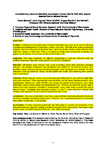Understanding Resource Allocation in social care for frail older people: lessons from a national survey
| dc.contributor.author | Asthana, Sheena | |
| dc.contributor.author | Stewart, K | |
| dc.contributor.author | hughes, J | |
| dc.contributor.author | Challis, D | |
| dc.contributor.author | Wordon, A | |
| dc.contributor.author | Davies, S | |
| dc.contributor.author | Xie, C | |
| dc.contributor.author | Gibson, Alexander | |
| dc.date.accessioned | 2020-12-07T13:42:03Z | |
| dc.date.issued | 2021-02-08 | |
| dc.identifier.issn | 2516-9122 | |
| dc.identifier.issn | 2516-9122 | |
| dc.identifier.uri | http://hdl.handle.net/10026.1/16714 | |
| dc.description.abstract |
Context: Traditionally local authorities in England allocated resources in social care following a professional assessment of need and a costed care plan. With the introduction of personal budgets, resource allocation tools have been used to provide service users with an initial indicative budget for their care. This is promoted as being more transparent, equitable and giving people greater control over decisions about their care. Objective: This study examined the different approaches to resource allocation and the content of resource allocation tools used for social care in England. Methods: Information was obtained from local authorities about their resource allocation systems. An analytic framework was developed and applied to the tools to explore: who identified needs; whether informal and formal support were recorded; and whether 17 need indicators covering functional status, mental health, and health and wellbeing were present and in what detail. Findings: Ninety-one per cent of 152 authorities responded and 61 per cent of authorities’ tools were analysed. Three approaches were identified: points-based self-assessment tools; standardised assessment data (FACE); and non-points-based/ready reckoner tools. Most authorities used a points-based selfassessment tool. All tools included the service user’s views and a high proportion included a professional’s view, while fewer covered the carer’s view on need. Coverage and presence of detail for the 17 need indicators showed high variation and was least on points-based self-assessment tools. Limitations: The study is the first to examine a large sample of resource allocation tools and provides a valuable baseline for future work. However, non-points-based/ready reckoner tools were under-represented in the sample. Implications: Further research could build upon this study to examine key properties of the tools used such as reliability, validity, sensitivity and specificity; and explore their impact upon service users and staff in terms of time use, cost, utility and equity. | |
| dc.format.extent | 43-57 | |
| dc.language | en | |
| dc.language.iso | en | |
| dc.publisher | LSE Press | |
| dc.title | Understanding Resource Allocation in social care for frail older people: lessons from a national survey | |
| dc.type | journal-article | |
| dc.type | Journal Article | |
| plymouth.volume | 2021 | |
| plymouth.publisher-url | https://journal.ilpnetwork.org/articles/10.31389/jltc.21/ | |
| plymouth.publication-status | Published | |
| plymouth.journal | Journal of Long-Term Care | |
| dc.identifier.doi | 10.31389/jltc.21 | |
| plymouth.organisational-group | /Plymouth | |
| plymouth.organisational-group | /Plymouth/Faculty of Health | |
| plymouth.organisational-group | /Plymouth/REF 2021 Researchers by UoA | |
| plymouth.organisational-group | /Plymouth/REF 2021 Researchers by UoA/UoA20 Social Work and Social Policy | |
| plymouth.organisational-group | /Plymouth/Research Groups | |
| plymouth.organisational-group | /Plymouth/Research Groups/FoH - Community and Primary Care | |
| plymouth.organisational-group | /Plymouth/Research Groups/Institute of Health and Community | |
| plymouth.organisational-group | /Plymouth/Research Groups/Plymouth Institute of Health and Care Research (PIHR) | |
| plymouth.organisational-group | /Plymouth/Users by role | |
| plymouth.organisational-group | /Plymouth/Users by role/Academics | |
| dcterms.dateAccepted | 2020-10-23 | |
| dc.rights.embargodate | 2021-4-24 | |
| dc.identifier.eissn | 2516-9122 | |
| dc.rights.embargoperiod | Not known | |
| rioxxterms.versionofrecord | 10.31389/jltc.21 | |
| rioxxterms.licenseref.uri | http://www.rioxx.net/licenses/all-rights-reserved | |
| rioxxterms.licenseref.startdate | 2021-02-08 | |
| rioxxterms.type | Journal Article/Review |


